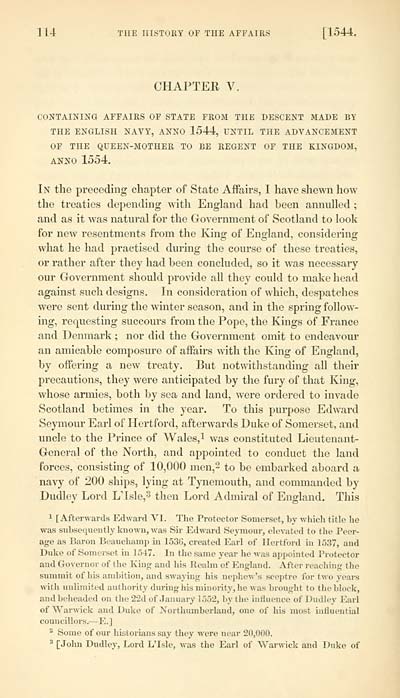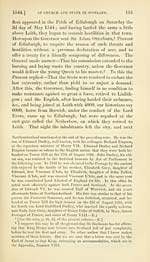Spottiswoode Society > History of the affairs of the Church and State of Scotland from the beginning of the reformation to the year 1568 > Volume 1
(250) Page 114
Download files
Complete book:
Individual page:
Thumbnail gallery: Grid view | List view

114 THE HISTORY OF THE AFFAIRS [1544.
CHAPTER V.
CONTAINING AFFAIRS OF STATE FROM THE DESCENT MADE BY
THE ENGLISH NAVY, ANNO 1544, UNTIL THE ADVANCEMENT
OF THE QUEEN-MOTHER TO BE REGENT OF THE KINGDOM,
ANNO 1554.
In the preceding chapter of State Affairs, I have shewn how
the treaties depending with England had been annulled ;
and as it was natural for the Government of Scotland to look
for new resentments from the King of England, considering
what he had practised during the course of these treaties,
or rather after they had been concluded, so it was necessary
our Government should provide all they could to make head
against such designs. In consideration of which, despatches
were sent during the winter season, and in the spring follow-
ing, requesting succours from the Pope, the Kings of France
and Denmark ; nor did the Government omit to endeavour
an amicable composure of affairs with the King of England,
by offering a new treaty. But notwithstanding all their
precautions, they were anticipated by the fury of that King,
whose armies, both by sea and land, were ordered to invade
Scotland betimes in the year. To this purpose Edward
Seymour Earl of Hertford, afterwards Duke of Somerset, and
uncle to the Prince of Wales, 1 was constituted Lieutenant-
General of the North, and appointed to conduct the land
forces, consisting of 10,000 men, 2 to be embarked aboard a
navy of 200 ships, lying at Tynemouth, and commanded by
Dudley Lord Lisle, 3 then Lord Admiral of England. This
1 [Afterwards Edward VI. The Protector Somerset, by which title he
was subsequently known, was Sir Edward Seymour, elevated to the Peer-
age as Baron Beauchamp in 1536, created Earl of Hertford in 1537, and
Duke of Somerset in 1547. In the same year he was appointed Protector
and Governor of the King and his Realm of England. After reaching the
summit of his ambition, and swaying his nephew's sceptre for two years
with unlimited authority during his minority, he was brought to the block,
and beheaded on the 22d of January 1552, by the influence of Dudley Earl
of Warwick and Duke of Northumberland, one of his most influential
councillors. — E.]
2 Some of our historians say they were near 20,000.
3 [John Dudley, Lord LTsle, was the Earl of Warwick and Duke of
CHAPTER V.
CONTAINING AFFAIRS OF STATE FROM THE DESCENT MADE BY
THE ENGLISH NAVY, ANNO 1544, UNTIL THE ADVANCEMENT
OF THE QUEEN-MOTHER TO BE REGENT OF THE KINGDOM,
ANNO 1554.
In the preceding chapter of State Affairs, I have shewn how
the treaties depending with England had been annulled ;
and as it was natural for the Government of Scotland to look
for new resentments from the King of England, considering
what he had practised during the course of these treaties,
or rather after they had been concluded, so it was necessary
our Government should provide all they could to make head
against such designs. In consideration of which, despatches
were sent during the winter season, and in the spring follow-
ing, requesting succours from the Pope, the Kings of France
and Denmark ; nor did the Government omit to endeavour
an amicable composure of affairs with the King of England,
by offering a new treaty. But notwithstanding all their
precautions, they were anticipated by the fury of that King,
whose armies, both by sea and land, were ordered to invade
Scotland betimes in the year. To this purpose Edward
Seymour Earl of Hertford, afterwards Duke of Somerset, and
uncle to the Prince of Wales, 1 was constituted Lieutenant-
General of the North, and appointed to conduct the land
forces, consisting of 10,000 men, 2 to be embarked aboard a
navy of 200 ships, lying at Tynemouth, and commanded by
Dudley Lord Lisle, 3 then Lord Admiral of England. This
1 [Afterwards Edward VI. The Protector Somerset, by which title he
was subsequently known, was Sir Edward Seymour, elevated to the Peer-
age as Baron Beauchamp in 1536, created Earl of Hertford in 1537, and
Duke of Somerset in 1547. In the same year he was appointed Protector
and Governor of the King and his Realm of England. After reaching the
summit of his ambition, and swaying his nephew's sceptre for two years
with unlimited authority during his minority, he was brought to the block,
and beheaded on the 22d of January 1552, by the influence of Dudley Earl
of Warwick and Duke of Northumberland, one of his most influential
councillors. — E.]
2 Some of our historians say they were near 20,000.
3 [John Dudley, Lord LTsle, was the Earl of Warwick and Duke of
Set display mode to: Large image | Transcription
Images and transcriptions on this page, including medium image downloads, may be used under the Creative Commons Attribution 4.0 International Licence unless otherwise stated. ![]()
| Permanent URL | https://digital.nls.uk/79599788 |
|---|
| Description | Volume I. |
|---|---|
| Attribution and copyright: |
|

